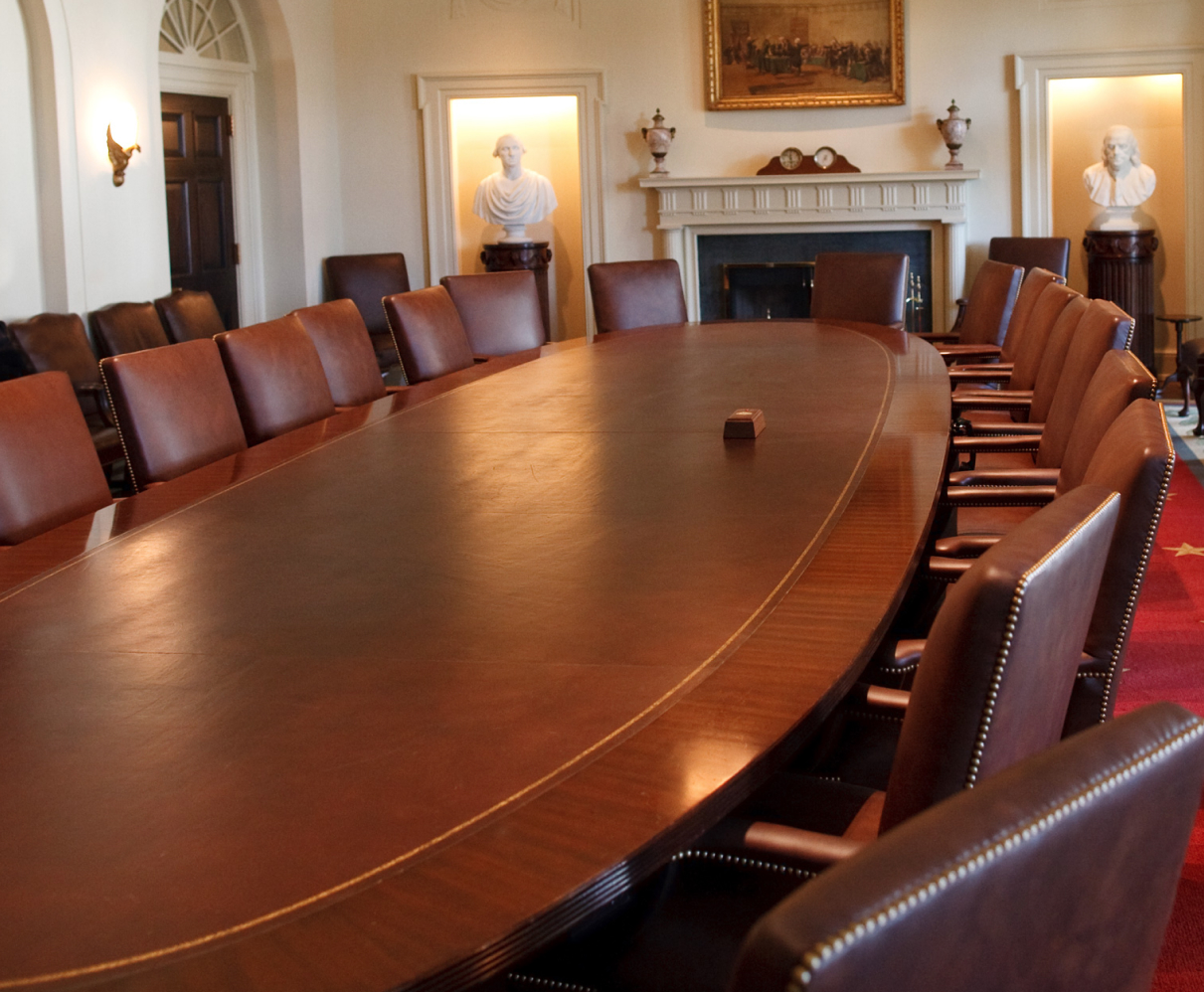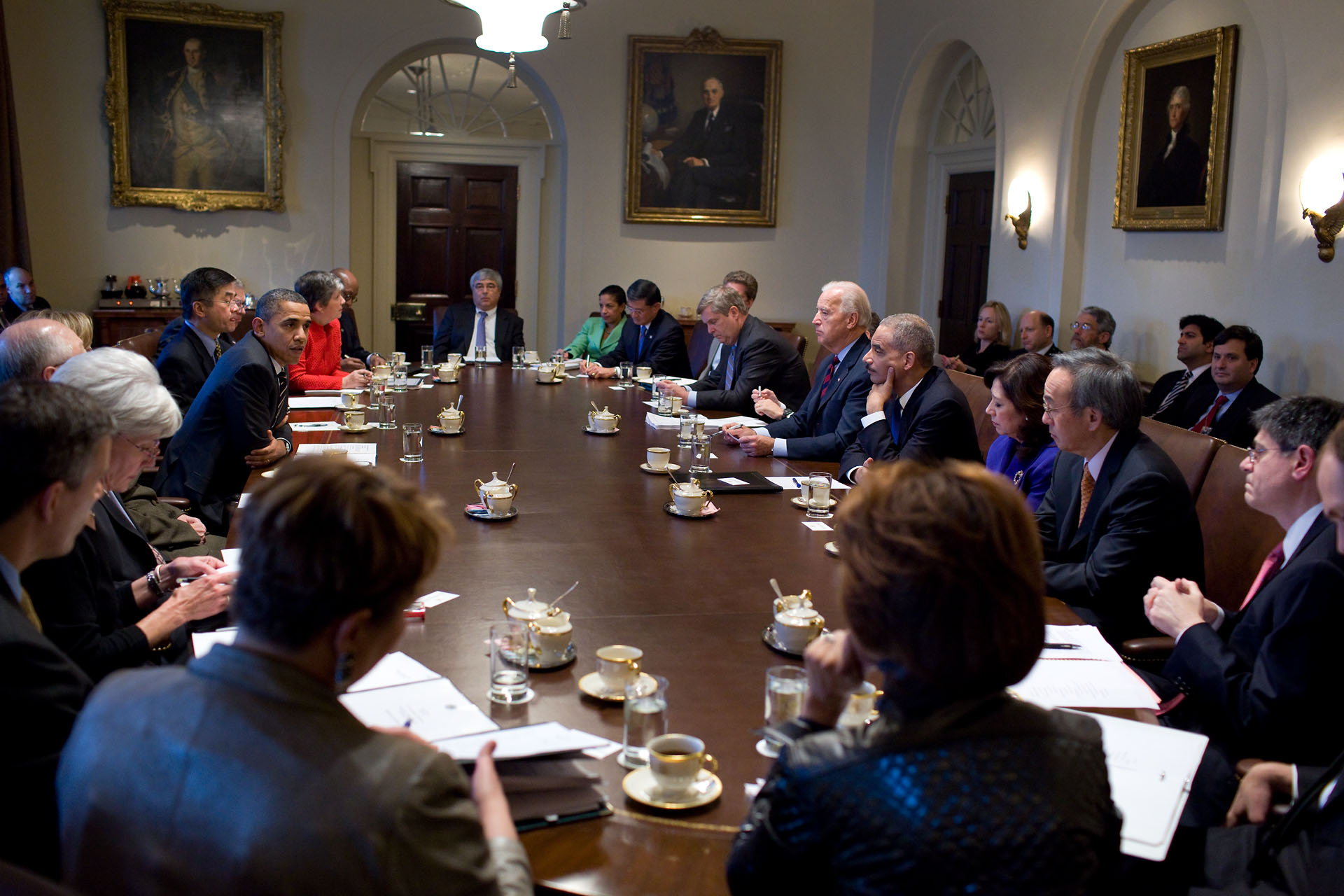History and Significance of the Cabinet Room: Cabinet Room White House

The Cabinet Room, located on the ground floor of the White House, is a historical and significant space that has witnessed countless moments in American history. It serves as a gathering place for the President and his Cabinet, where critical decisions shaping the nation’s future are made.
The Cabinet Room’s history can be traced back to the early days of the American presidency. President George Washington held his first Cabinet meetings in the White House in 1790, though the exact location of these meetings is uncertain. Over the years, the Cabinet Room has undergone several transformations, both in terms of its design and its purpose.
Evolution of the Cabinet Room
The Cabinet Room’s location within the White House has shifted throughout history. Initially, it was situated on the second floor, but in 1902, President Theodore Roosevelt moved it to its current location on the ground floor. This relocation coincided with the construction of the West Wing, which provided a more suitable and secure space for the Cabinet Room.
Significance of the Cabinet Room
The Cabinet Room is a symbol of the American presidency and its role in shaping the nation’s destiny. It serves as a forum for the President and his Cabinet to discuss and debate crucial issues facing the country. The decisions made in the Cabinet Room can have a profound impact on the lives of millions of Americans, both domestically and internationally.
Design and Layout
The Cabinet Room is a relatively small room, with a distinctive rectangular shape. Its walls are adorned with portraits of past presidents, while the fireplace serves as a focal point for the room. The Cabinet Room’s design reflects the importance of tradition and continuity in the American presidency.
Unique Features
The Cabinet Room is distinguished by several unique features, including its historical significance, its role in decision-making, and its design. The room is a testament to the enduring power of the American presidency and its impact on the world stage.
Key Features and Functions of the Cabinet Room

The Cabinet Room, a pivotal space within the White House, serves as a critical hub for presidential decision-making and executive action. It is a place where the President convenes with their closest advisors to discuss, debate, and ultimately determine the course of the nation. The room’s design and functionality are carefully crafted to foster an environment conducive to thoughtful deliberation and decisive action.
Features of the Cabinet Room, Cabinet room white house
The Cabinet Room’s design and features are a testament to its significant role in American governance.
- Furniture: The room is furnished with a large, oval-shaped table that seats up to 20 people. This arrangement promotes a sense of equality and collaboration among participants. The table’s shape symbolizes the importance of open communication and shared decision-making. Additionally, the room features comfortable chairs and a fireplace, creating a welcoming and intimate atmosphere.
- Artwork: The Cabinet Room is adorned with several notable works of art. These pieces reflect the history and values of the United States, serving as visual reminders of the importance of the room’s function. The room’s artwork includes portraits of past presidents, landscapes depicting the American landscape, and still lifes that represent the nation’s bounty.
- Technology: The Cabinet Room is equipped with state-of-the-art technology, including video conferencing capabilities, high-speed internet access, and a sophisticated audio system. This ensures that the President and their advisors can stay connected with the world and access vital information during meetings.
Functions of the Cabinet Room
The Cabinet Room serves a variety of crucial functions in the day-to-day operations of the White House.
- Meetings: The Cabinet Room is the primary venue for the President’s meetings with their Cabinet, a group of senior advisors responsible for overseeing various government departments. These meetings provide a forum for the President to receive updates on key issues, discuss policy options, and make critical decisions.
- Briefings: The Cabinet Room is also used for briefings by top government officials, including intelligence reports, economic forecasts, and updates on foreign affairs. These briefings keep the President informed about the most pressing issues facing the nation and allow them to make informed decisions.
- Official Ceremonies: The Cabinet Room is occasionally used for official ceremonies, such as the signing of executive orders or the swearing-in of new cabinet members. These events are often televised and provide the public with a glimpse into the workings of the White House.
A Hypothetical Scenario for Presidential Decision-Making
Imagine a scenario where the President is faced with a major foreign policy crisis. After receiving briefings from national security advisors and intelligence officials, the President calls a meeting in the Cabinet Room. The President, seated at the oval table, invites the heads of the State Department, Defense Department, and intelligence agencies to share their perspectives and recommendations.
The Cabinet Room’s atmosphere encourages open dialogue and thoughtful consideration of various options. The President, guided by the advice of their advisors, listens attentively to each perspective. They use the room’s technology to access real-time information and consult with experts around the world.
The discussion in the Cabinet Room may be heated, but the room’s design fosters a spirit of collaboration. The President ultimately weighs the options and makes a decision based on the best available information and the counsel of their trusted advisors. This decision, born from the deliberations in the Cabinet Room, will have a profound impact on the nation’s future.
The Cabinet Room in Popular Culture

The Cabinet Room, a symbol of American power and decision-making, has transcended the confines of the White House and found its way into the realm of popular culture. From cinematic portrayals to literary narratives, the room has become a recurring motif, reflecting both its historical significance and the enduring fascination with the inner workings of government.
The Cabinet Room’s presence in popular culture has shaped public perception, offering glimpses into the behind-the-scenes world of presidential decision-making and showcasing the gravity of the issues discussed within its walls. Through these depictions, the room has taken on a symbolic weight, representing not just a physical space but also a crucible of power, strategy, and the fate of nations.
Depictions in Film and Television
The Cabinet Room has been a frequent setting in films and television shows, often serving as a backdrop for dramatic confrontations, crucial negotiations, and pivotal moments in history. Its inclusion in these works provides viewers with a tangible representation of the presidential experience, allowing them to imagine themselves in the room where history is made.
- The 1976 film “Network,” starring William Holden, features a memorable scene in which a group of executives gathers in a room resembling the Cabinet Room to discuss the fate of a television network. This scene, while fictional, captures the tension and high stakes that often accompany decision-making in high-powered settings.
- The television series “The West Wing” (1999-2006), a fictionalized account of the inner workings of the White House, features numerous scenes set in the Cabinet Room. These scenes depict the president and his advisors engaging in spirited debates, navigating complex policy issues, and grappling with the pressures of leadership. The show’s depiction of the Cabinet Room, while fictionalized, offers viewers a glimpse into the day-to-day operations of the White House and the challenges faced by those in positions of power.
The Cabinet Room in Literature
The Cabinet Room has also found its way into the pages of literature, where authors have used it as a setting to explore themes of power, politics, and the human condition.
- In his 2007 novel “The Devil’s Advocate,” author John Grisham uses the Cabinet Room as a setting for a dramatic confrontation between a powerful lawyer and a corrupt politician. The scene highlights the room’s symbolic significance as a place where deals are made and destinies are shaped.
- The 2018 novel “The President’s Daughter” by Bill Clinton and James Patterson features a scene in which the President and his advisors gather in the Cabinet Room to discuss a national security threat. The scene emphasizes the room’s role as a center of crisis management and the weight of responsibility that falls upon the shoulders of those who occupy it.
A Fictional Narrative
In the heart of the White House, the Cabinet Room stood silent, its mahogany table gleaming under the soft glow of the chandelier. The air hung heavy with anticipation as President Eleanor Vance addressed her advisors. The nation was on the brink of war, and the weight of history pressed down on their shoulders.
“We have a choice to make,” the President said, her voice firm and resolute. “A choice that will shape the future of our nation and the world.”
The advisors, a diverse group of experts and strategists, exchanged nervous glances. The stakes were high, and the consequences of their decision would reverberate for generations to come.
As the debate raged on, the Cabinet Room became a crucible of ideas, a battleground of ideologies. The air crackled with tension, the room echoing with the clash of opinions and the weight of responsibility.
The President, her gaze fixed on the faces of her advisors, saw the fear, the doubt, the determination in their eyes. This was not just a meeting; it was a defining moment in their lives, a moment that would forever alter the course of history.
“We are the guardians of our nation’s destiny,” she said, her voice rising above the din. “And in this room, we must make the choices that will shape our future.”
As the hours ticked by, the advisors grappled with the complex issues at hand, their minds racing with scenarios and consequences. The Cabinet Room, a symbol of power and responsibility, became a witness to the human drama unfolding within its walls.
The decision they made that night would have far-reaching consequences, shaping the destiny of a nation and the world. And as they left the Cabinet Room, each advisor carried with them the weight of their decision, knowing that they had played a part in shaping the future.
Cabinet room white house – The Cabinet Room in the White House, a space where critical decisions shaping the nation are made, holds an aura of gravitas and solemnity. Yet, even in such a place, the human spirit seeks harmony and balance. Perhaps a glimpse of this is found in the soothing influence of colors, such as those found in a purple and turquoise bedroom , where tranquility and creativity intertwine.
Just as these hues inspire a sense of calm and clarity in a personal space, they could offer a subtle reminder to those within the Cabinet Room of the importance of thoughtful reflection and peaceful resolution in the face of complex challenges.
The Cabinet Room in the White House, a space where critical decisions shape the nation, resonates with the same energy as a kitchen where nourishing meals are prepared. Just as the White House chefs carefully select ingredients to create delectable dishes, homeowners often seek the perfect white paint for their kitchen cabinets, a decision that can transform the space into a haven of warmth and elegance.
Finding the ideal shade, like choosing the right cabinet members, requires careful consideration. For those seeking a timeless and refined look, exploring the best Valspar white for kitchen cabinets can be a rewarding journey, much like the process of selecting the right individuals to advise the President.
